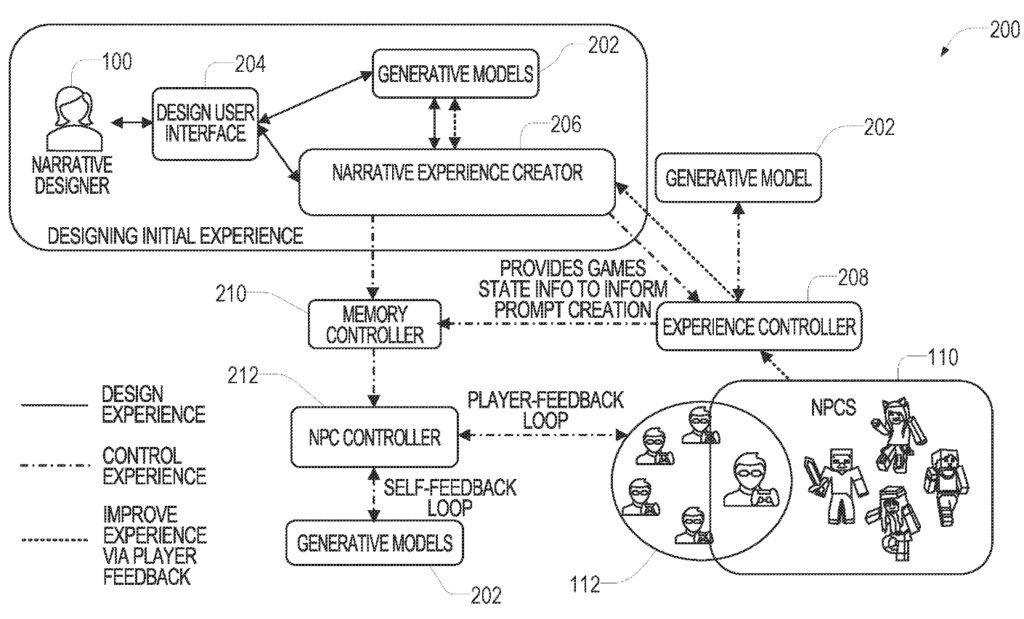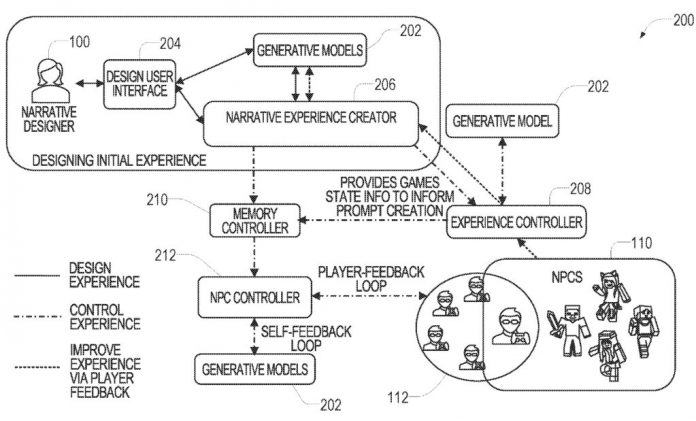Microsoft has filed a patent for a generative AI system designed to transform how video game narratives are created and adapted. The system enables developers to craft detailed storylines and game worlds from high-level descriptions while allowing players to influence these elements dynamically through real-time feedback.
By integrating AI models, the patented technology focuses on evolving the storytelling experience in ways that respond to both creative direction and player interaction.
The patent highlights methods to automate parts of game design, such as generating characters, plotlines, and environments. At the same time, it introduces tools for collecting and analyzing player engagement data to refine gameplay.
This dual approach, combining developer creativity and player agency, represents a step toward a new era of interactive storytelling.
Related: Nvidia Unveils AI Gaming Characters That Plan and Act Like Human Players
Building Game Narratives with AI
Central to Microsoft’s patent is the use of generative AI models like OpenAI’s GPT-series, which process developer prompts to produce detailed content. Developers can input overarching themes or basic story elements, and the AI generates characters, quests, and game settings.
The system’s iterative process enables designers to refine AI-generated content, combining automation with human creativity.
One innovation described in the patent is the “narrative state graph.” This framework structures a game’s story into nodes that represent key events or decisions, creating a dynamic map of interconnected paths.


The graph not only helps developers visualize complex narratives but also allows for real-time adaptation based on player choices. For example, an NPC could respond to a player’s actions by introducing new quests or altering the story trajectory.
This technology also enables integration into sandbox games like Minecraft. Players could issue prompts, such as requesting new gameplay rules, NPC behaviors, or entire story arcs. According to the patent, “The game may allow players to diverge from the pre-defined game experience and explore new possibilities of gameplay, including by interacting with integrated computer-controlled agents that prompt generative models to create new game content responsive to player input on the fly.”
Related: NVIDIA Introduces Reflex 2: Record-Breaking 75% Latency Gains with Predictive Rendering
Player Feedback as a Design Element
Microsoft’s system relies heavily on engagement metrics, which measure how players interact with the game. These metrics include time spent in specific areas, the frequency of interactions with NPCs, and completion rates for tasks. By analyzing these metrics, the AI can identify what players find most engaging and adapt the game accordingly.
For example, a side quest that receives high engagement could be expanded into a main storyline in future game iterations. Conversely, elements with low engagement might be reworked or removed. The patent describes this process as a feedback loop, enabling a collaborative evolution of the game experience between designers, players, and AI.
This player-driven approach ensures games remain dynamic and personalized. The system can also cater to individual preferences by tailoring storylines to specific playstyles, creating unique experiences for each user.
Related: NVIDIA, Streamlabs and Inworld Launch AI for Live Stream Management
Microsoft’s patent is part of its broader commitment to AI, underscored by its multibillion-dollar investment in OpenAI. Generative AI has become a focal point for innovation across industries, and gaming is no exception. However, the technology’s adoption has sparked debates about its impact on creativity and labor in game development.
Haiyan Zhang, Xbox’s Head of Gaming AI, remarked last summer that “AI will augment game developers, but the technology isn’t a replacement for actual humans working on a project.” This sentiment reflects Microsoft’s positioning of AI as a tool for enhancing human creativity rather than supplanting it.
Related: Microsoft to Unify Xbox and Windows Gaming Ecosystems
Similarly, Brian Fargo, CEO of inXile Entertainment, a Microsoft-owned game studio, stated already in 2023, “I’m interested in some aspects of how AI can aid game development, but I’m not convinced AI has any place in crafting game narratives or NPCs.”
Other industry players are also exploring generative AI. Electronic Arts recently demonstrated AI-driven tools for creating customizable game worlds, while NVIDIA has integrated AI-powered NPCs to enrich player interactions. These advancements highlight the potential of AI in gaming but also raise ethical concerns, including the risks of job displacement and the use of training data.
How This Technology Could Reshape Gaming
Microsoft’s patent provides a glimpse into a future where games are no longer static creations but living experiences that evolve in response to players. The system’s ability to generate dynamic content, combined with player feedback, could redefine the relationship between developers and their audiences.
For instance, the system might enable developers to test multiple storylines based on player preferences before finalizing game updates. In multiplayer settings, it could adapt narratives to reflect collective actions, fostering collaborative storytelling among players. As generative AI continues to advance, this technology could blur the line between creator and participant, making games more interactive and immersive.

